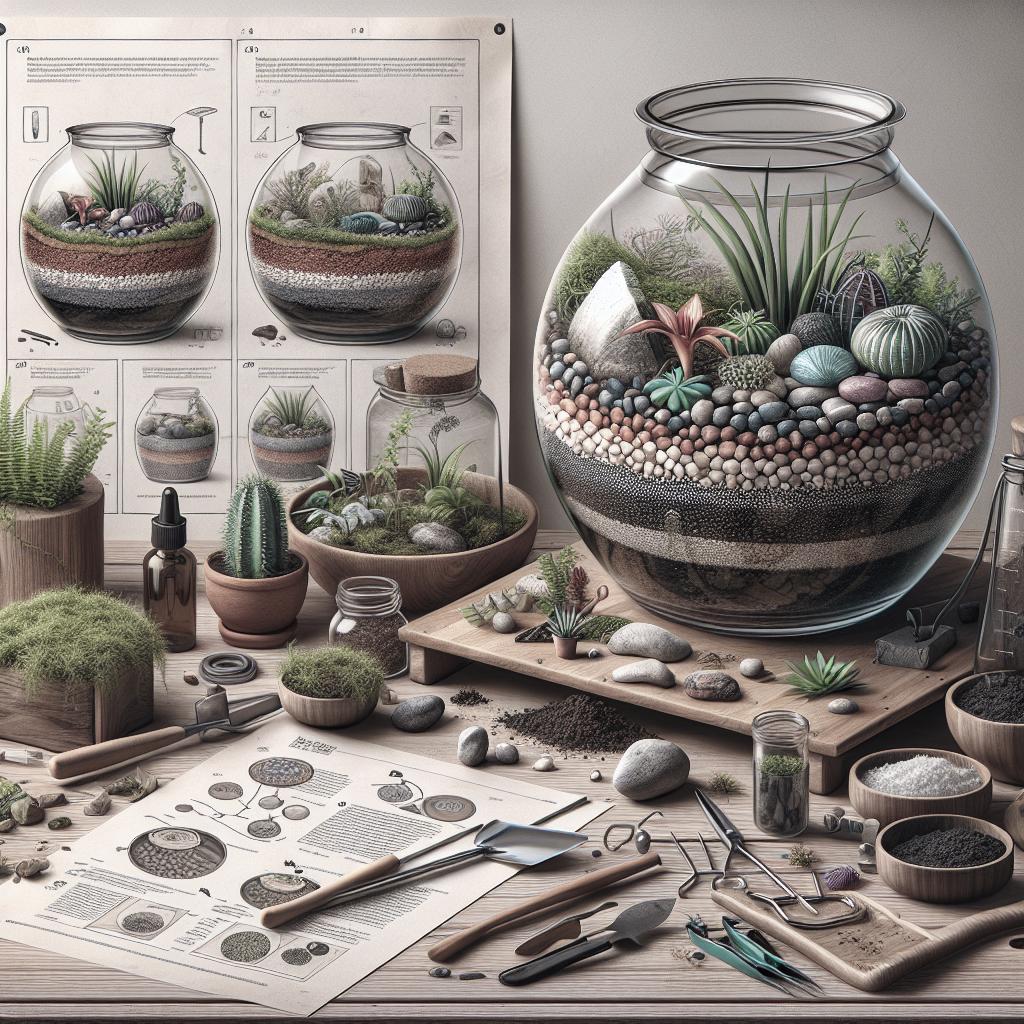DIY Terrarium Building Guide
A terrarium is a delightful miniature ecosystem enclosed within a glass container. It’s an artful way to bring a slice of nature indoors and can be personalized to suit your aesthetic preferences. Whether you’re housing tropical plants or creating a lush jungle fantasy, terrariums are perfect for garden enthusiasts looking to nurture a mini Eden. In this guide, we will cover everything you need to know about building your own terrarium, from selecting the right materials to helpful maintenance tips. Once equipped with your homemade terrarium, you’ll find joy in watching your miniature landscape thrive and evolve. Furthermore, for animal lovers, we provide insights into incorporating small fauna into your terrarium.
Before Getting Started
Click Play to Learn How to Make a Basic Terrarium
Before diving into the hands-on part of terrarium building, it’s beneficial to learn the basics through visual demonstration. A quick, engaging video can be your best teacher. Click the play button to unravel the mystery of terrarium building, providing insight into each step and common pitfalls to avoid. This introduction is invaluable for novices.
Watching the transformation from a mere glass container to a living exhibit can be quite magical. Don’t skip this step as it acts as an excellent primer, setting you up for success. Understanding the order of materials and a brief explanation of plant needs will ensure you’re ready to move on to the more detailed instructions in this guide.
What You’ll Need
Equipment / Tools
Creating a terrarium requires basic tools that are relatively easy to find. At the top of your checklist should be gloves to protect your hands, a small trowel or spoon for scooping, tweezers for detailed placement, and scissors for trimming excess foliage. These tools ensure that every layer and every plant are perfectly placed.
Additionally, it’s wise to have a funnel or a small watering can with a narrow spout for watering. This setup facilitates precision in pouring, necessary to avoid overly watering the soil, which is crucial as excess moisture can compromise the health of the terrarium.
Materials
Materials form the core of your terrarium and they include the container, plants, potting soil, and layers of drainage components like pebbles and activated charcoal. Start with a clear, glass container; while any shape can work, ensure it has an opening large enough for you to work your hand through comfortably.
Next, gather small pebbles or gravel as a base layer, and activated charcoal to keep the environment odor-free and remove toxins. You’ll need sphagnum moss, which acts as a barrier to stop soil from settling among pebbles. For the potting medium, use a high-quality potting mix that accommodates the plants’ needs.
Instructions
Building a terrarium is akin to assembling a carefully layered trifle dessert, where each component serves a purpose for the healthy thriving of plants. Patience and attention to detail will yield the best results, as even the tiniest action can impact the living organisms within.
Don’t rush the process. Instead, take the time to visualize each step before execution, ensuring that layers are distinct and accurate. This meticulous approach not only affects the aesthetic appeal but also the functional quality, ensuring appropriate drainage and plant health.
How to Make a Terrarium
Choose a Container
The first step in building a terrarium is selecting a container. Consider the size relative to the space where you’ll place it. It should be clear to allow light penetration, essential for photosynthesis. Additionally, an open container is best for arid plants, like cacti, whereas closed options are better for humidity-loving plants.
Tip
When selecting a container, don’t hesitate to explore creative options like a fishbowl, mason jar, or even a light bulb. The container plays a vital role as a showcase for your creation. Just ensure visibility and access for maintenance purposes.
Choose the Plants
Choice of plants is paramount, affecting both aesthetics and survivability. Popular choices for terrariums include ferns, succulents, mosses, and air plants. The crucial aspect here is plant selection should be based on their shared environmental needs, ensuring compatibility within the close confines.
Add Drainage Layers
Create a solid drainage layer at the base of the container with your pebbles or gravel. This will prevent waterlogging and help maintain an equilibrium of moisture. Place a 1-2 inch layer of gravel, followed by activated charcoal, to manage odor and promote filtration.
Add Moss and Potting Mix
Apply a thin layer of sphagnum moss over the gravel to act as a soil barrier. On top of this, gently place your chosen potting mix. The depth of this layer should depend on the type of plants being used, usually accounting for roughly 2-3 inches.
Prepare the Plants
Prior to planting, visualize the placement plan. Remove excessive soil from the plants’ roots and trim any dead foliage. This preparation enhances the plant’s chance for healthy growth and aligns with the aesthetic vision for your terrarium.
Add Plants
Strategically place your plants into the soil, starting from the largest and ending with the smallest. Use tweezers for precise arrangements, creating a natural look. Ensure each plant is secure by lightly pressing its roots down with soil.
Tip
Design your plant layout with scale and layering in mind. Larger plants in the background and smaller ones in the foreground will create depth, and vignette design can further enhance the visual appeal.
Decorate
Personalize your terrarium with decorative items such as small statues, colored stones, or themed ornaments. Don’t overcrowd the plants; instead, use decor to enhance their natural beauty, adding whimsy and character to your miniature world.
Water the Terrarium
Once set, gently water the terrarium using a small amount of water to settle the soil. The first watering creates a necessary moisture layer, kickstarting the ecosystem without overwhelming it. Use distilled or rainwater for best results, as tap water can introduce contaminants.
Maintain the Plants
Ongoing maintenance is crucial to terrarium health. Regularly check on moisture levels—your terrarium should have condensation, but the soil shouldn’t be overly saturated. Prune dead leaves and watch for signs of distress, like discoloration.
How to Make a Terrarium With Animals
Introducing animals adds dynamic movement and intrigue to your terrarium. Small creatures such as snails, small frogs, or even isopods can be suitable inhabitants. Start by researching the specific needs of each species to ensure they will thrive in your environment.
The inclusion of animals not only enhances the bioactive system but also requires additional considerations, such as supplementary heat sources and a more sophisticated understanding of humidity levels. Creating a harmonious balance between flora and fauna is ultimately the key to a successful terrarium with animal life.
A well-thought-out plan will allow both plants and animals to coexist happily in their glass home. Regular maintenance, including feeding and cleaning, should be adapted to support their lifecycles, therefore caring for the overall health of your miniature ecosystem.
Lessons Learned
| Key Aspect | Summary |
|---|---|
| Preparation | Understand the basics through instructional videos, and gather the necessary tools and materials. |
| Materials | Select the right container and gathering essential components like soil, plants, and decorative elements. |
| Construction | Step-by-step building from drainage to planting, ensuring each layer is appropriately placed. |
| Animal Integration | Additional research needed for introducing fauna, with special attention to their care and habitat. |
| Maintenance | Regular care including watering, pruning, and balance checks to sustain the life within. |
This HTML document encapsulates a comprehensive guide for building a DIY terrarium, incorporating practical advice and systematic steps to create your own miniature garden within a glass container. The “Lessons Learned” section effectively summarizes key takeaways, serving as a snapshot of the process for both beginners and enthusiasts.


